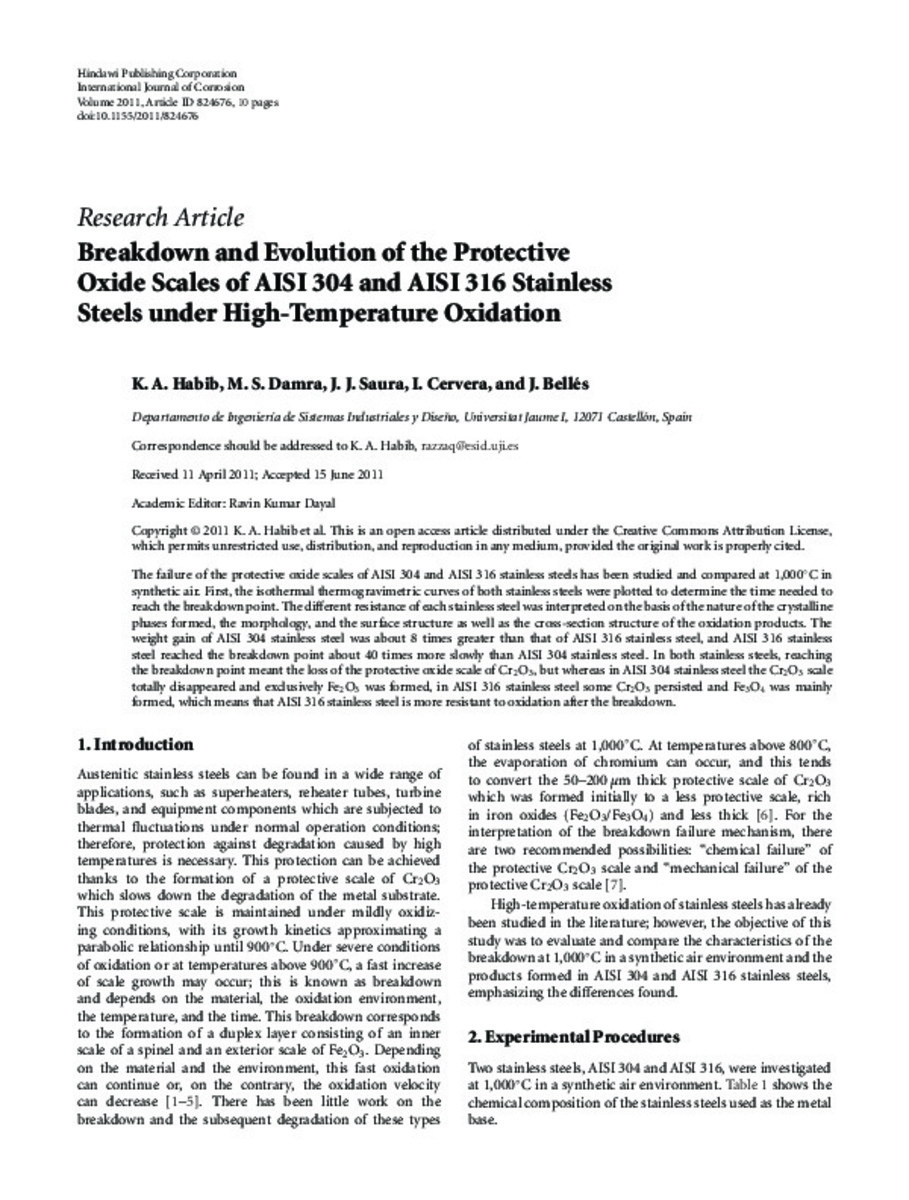Mostrar el registro sencillo del ítem
Breakdown and evolution of the protective oxide scales of AISI 304 and AISI 316 stainless steels under high-temperature oxidation
| dc.contributor.author | Habib Ameen, Kudama | |
| dc.contributor.author | Damra, M. S. | |
| dc.contributor.author | Saura Barreda, Juan J. | |
| dc.contributor.author | Cervera González, Iván | |
| dc.contributor.author | Bellés Bellés, Joan | |
| dc.date.accessioned | 2012-06-13T06:37:39Z | |
| dc.date.available | 2012-06-13T06:37:39Z | |
| dc.date.issued | 2011 | |
| dc.identifier.citation | International Journal of Corrosion (2011), vol. 2011, article ID 824576, 1-10 | ca_CA |
| dc.identifier.issn | 1687-9325 | |
| dc.identifier.issn | 1687-9333 | |
| dc.identifier.uri | http://hdl.handle.net/10234/41541 | |
| dc.description.abstract | The failure of the protective oxide scales of AISI 304 and AISI 316 stainless steels has been studied and compared at 1,000°C in synthetic air. First, the isothermal thermogravimetric curves of both stainless steels were plotted to determine the time needed to reach the breakdown point. The different resistance of each stainless steel was interpreted on the basis of the nature of the crystalline phases formed, the morphology, and the surface structure as well as the cross-section structure of the oxidation products. The weight gain of AISI 304 stainless steel was about 8 times greater than that of AISI 316 stainless steel, and AISI 316 stainless steel reached the breakdown point about 40 times more slowly than AISI 304 stainless steel. In both stainless steels, reaching the breakdown point meant the loss of the protective oxide scale of Cr2O3, but whereas in AISI 304 stainless steel the Cr2O3 scale totally disappeared and exclusively Fe2O3 was formed, in AISI 316 stainless steel some Cr2O3 persisted and Fe3O4 was mainly formed, which means that AISI 316 stainless steel is more resistant to oxidation after the breakdown. | ca_CA |
| dc.format.extent | 10 p. | ca_CA |
| dc.format.mimetype | application/pdf | ca_CA |
| dc.language.iso | eng | ca_CA |
| dc.publisher | Hindawi Publishing Corporation | ca_CA |
| dc.rights | Copyright © 2011 K. A. Habib et al. This is an open access article distributed under the Creative Commons Attribution License, which permits unrestricted use, distribution, and reproduction in any medium, provided the original work is properly cited | ca_CA |
| dc.rights.uri | http://creativecommons.org/licenses/by-sa/4.0/ | |
| dc.subject | AISI 304 | ca_CA |
| dc.subject | AISI 316 | ca_CA |
| dc.subject | Stainless steels | ca_CA |
| dc.subject | Protective oxide scales | ca_CA |
| dc.subject | Breakdown point | ca_CA |
| dc.title | Breakdown and evolution of the protective oxide scales of AISI 304 and AISI 316 stainless steels under high-temperature oxidation | ca_CA |
| dc.type | info:eu-repo/semantics/article | ca_CA |
| dc.identifier.doi | http://dx.doi.org/10.1155/2011/824676 | |
| dc.rights.accessRights | info:eu-repo/semantics/openAccess | ca_CA |
| dc.relation.publisherVersion | http://www.hindawi.com/journals/ijc/2011/824676/ref/ | ca_CA |
Ficheros en el ítem
Este ítem aparece en la(s) siguiente(s) colección(ones)
-
ESID_Articles [465]
Excepto si se señala otra cosa, la licencia del ítem se describe como: Copyright © 2011 K. A. Habib et al. This is an open access article distributed under the Creative Commons Attribution License, which permits unrestricted use, distribution, and reproduction in any medium, provided the original work is properly cited








